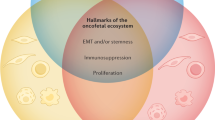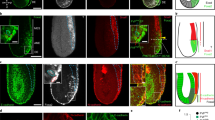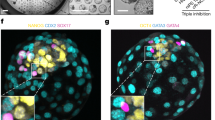Abstract
F9 is a clonal line of mouse teratocarcinoma-derived embryonal carcinoma (EC) cells which shows very little spontaneous differentiation in vivo or in vitro1. Recently, however, it was reported2–6 that F9 monolayers treated with retinoic acid and dibutyryl cyclic AMP differentiate into an early embryonic cell type known as parietal endoderm, which is one of two distinct populations of extra-embryonic endoderm that differentiate in the normal mouse embryo shortly after implantation7,8. The other population is the visceral endoderm, and the two differ not only in their morphology and location within the embryo, but also in their biochemical properties9–12. Parietal endoderm cells, for example, do not synthesize α-fetoprotein13 (AFP), whereas visceral endoderm cells do13. There is evidence8 that during embryogenesis parietal and visceral endoderm are derived from a common precursor population known as the primary endoderm, and recent experiments with cultured mouse embryos14 suggest that the phenotype of these cells can be modulated by contact with different embryonic tissues. We now show that if F9 EC cultures are treated with retinoic acid when they are in the form of small aggregates, they differentiate on the outer surface cells which morphologically resemble visceral rather than parietal endoderm. In addition, the cells synthesize and secrete AFP, identified by immunoprecipitation and immunoperoxidase reactions using specific anti-AFP immunoglobulin. One interpretation of this result is that F9 cells treated with retinoic acid differentiate first into multipotent cells analogous to the primary endoderm of the normal embryo which then express either the mature parietal or visceral phenotype depending on the nature of the intercellular contact signals they receive. We therefore believe that F9 EC cells may be even more useful than previously supposed for biochemical studies on factors controlling gene expression during mammalian embryogenesis.
This is a preview of subscription content, access via your institution
Access options
Subscribe to this journal
Receive 51 print issues and online access
$199.00 per year
only $3.90 per issue
Buy this article
- Purchase on Springer Link
- Instant access to full article PDF
Prices may be subject to local taxes which are calculated during checkout
Similar content being viewed by others
References
Sherman, M. I. & Miller, R. A. Devl Biol. 63, 27–34 (1978).
Strickland, S. & Mahdavi, V. Cell 15, 393–403 (1978).
Solter, D., Shevinsky, L., Knowles, B. B. & Strickland, S. Devl Biol. 70, 515–521 (1979).
Strickland, S. & Sawey, M. J. Devl Biol. 78, 76–85 (1980).
Jetten, A. M., Jetten, M. E. R. & Sherman, M. I. Expl Cell Res. 124, 381–391 (1979).
Strickland, S., Smith, K. K. & Marotti, K. R. Cell 21, 347–355 (1980).
Enders, A. C., Given, R. L. & Schlafke, S. Anat. Rec. 190, 65–78 (1978).
Gardner, R. L. in Results and Problems in Cell Differentiation Vol. 9 (ed. Gehring, W. J.) 205–241 (Springer, Berlin, 1978).
Adamson, E. D. & Ayers, S. E. Cell 16, 953–965 (1979).
Hogan, B. L. M., Cooper, A. & Kurkinen, M. Devl Biol. 80, 289–300 (1980).
Howe, C. C. & Solter, D. Devl Biol. 77, 480–487 (1980).
Hogan, B. L. M. Devl Biol. 76, 275–285 (1980).
Dziadek, M. & Adamson, E. J. Embryol. exp. Morph. 43, 298–313 (1978).
Hogan, B. L. M. & Tilly, R. J. Embryol. exp. Morph. (in the press).
Martin, G. R., Wiley, L. M. & Damjanov, I. Devl Biol. 61, 230–244 (1977).
Lo, C. W. & Gilula, N. B. Devl Biol. 75, 93–111 (1980).
Solter, D., Damjanov, I. & Skreb, N. Anat. entwgesch. Monogr. 132, 291–298 (1970).
Laemmli, U. K. Nature 227, 680–685 (1970).
Author information
Authors and Affiliations
Rights and permissions
About this article
Cite this article
Hogan, B., Taylor, A. & Adamson, E. Cell interactions modulate embryonal carcinoma cell differentiation into parietal or visceral endoderm. Nature 291, 235–237 (1981). https://doi.org/10.1038/291235a0
Received:
Accepted:
Issue Date:
DOI: https://doi.org/10.1038/291235a0
This article is cited by
-
Extracellular syntaxin4 triggers the differentiation program in teratocarcinoma F9 cells that impacts cell adhesion properties
Cell and Tissue Research (2013)
-
Dynamic expression of Dab2 in the mouse embryonic central nervous system
BMC Developmental Biology (2008)
-
Chromatin signatures of pluripotent cell lines
Nature Cell Biology (2006)
-
Endogenous and transfected mouse alpha-fetoprotein genes in undifferentiated F9 cells are activated in transient heterokaryons
Somatic Cell and Molecular Genetics (1995)
-
Immortalization of committed precursor cells from mouse teratocarcinoma using an adenovirus-SV40 recombinant plasmid
Methods in Cell Science (1995)
Comments
By submitting a comment you agree to abide by our Terms and Community Guidelines. If you find something abusive or that does not comply with our terms or guidelines please flag it as inappropriate.



